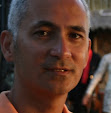Having just finished some extensive tours of heritage sites in Kyoto, Nara and Kamakura, I was a little bit "templed out" from seeing more sites which were starting to blur from the multiples of artwork and detailed carvings at each site. In order to prevent a fast burn out, I decided to take a more laid back approach and follow my B&B host's tip on a more sedate hike along the Daiya river, passing the iconic red Shinkyo bridge, and the gateway to the national park grounds. Even though the bridge is on everyone's first "Must do photo shot", I thought it was quite beautiful framed with the first hint of autumn's glory and the range of pale blue mountains in the distance.
Walking along the river, I start seeing more fall foliage with the pyracantha, aralia and japanese maples starting their colorful transformation to burnt oranges, ochres and indian red leaved foliage. Even though this area is just getting starting to transition to autumn, I can already envision what this whole view will look like a few weeks filled with vibrant fall colors all along the river banks and into the hillsides.
Continuing along the trail, I trudge onward through a forested area. The river gets very narrow and is hidden from view from thick jungle, but then suddenly becomes dramatically visible against huge and rounded boulders lining the curved banks. The river is swirling into aqua blue pools and short waterfalls cascading down their banks. Its stunning, and I breath deeply while taking in all the woody and pastoral views to this scenic panorama.

Continuing along the solitary path, I pass by a few locals walking around the paths with their dogs, conversing (I imagine) about the day's happenings and some juicy gossip while the dogs run around aimlessly through the graveled areas. Finally, I reach my destination and walk through the dilapidated wooden arbor into the Jizu shrine - its mostly a string of almost seventy Buddha-like statues lining the banks of the Daiya river. Each Buddha is donning a fuchsia red bib and matching crochet hat. I didn't really know the significance of these Buddha's until I researched and found out that they represent Bodhisattva who console those that are traveling or deceased souls awaiting rebirth, hence the formations along the pathways and river banks greeting travelers in their midst.
In Japanese they are called Bake-Jizo or Hyaku-jizu. This solo Bake-jizu seemed to have lost its cap but gained a pair of white miniature straw slippers. Enveloped with a verdant green body of thick moss, lichen and ferns, I almost wanted to take this and bring it back home (I wish) and make a perfect addition to my zen garden.
On the other side of the river is the Nikko botanical garden, and you could just see some small waterfalls,walking trails and a variety of maples turning colors along the river bank. Unfortunately, there were no crossing to the other side so I could not visit the garden on this tour, but getting a glimpse from the other side was a nice visual treat.
Climbing over some boulders to a small pagoda overlooking the river, I sit a spell to take it all in and cherish this special moment - knowing that my trip will be ending very soon. I'm quite content to have started the last part of my visit in Nikko with an easy walk just to reflect on my travels in Japan and enjoy the panorama around me. This spot was also perfect for capturing some great photos with a nice vantage point of the riverbanks and valley.
The trail continues climbing through some stone walkways all the way to the top of this hillside where there is a small waterfall. At this point, I decide to head back down to the city because dusk is falling quickly and I want to make sure that I wouldn't get lost in the dark on the way back into town. It was a fantastic hike and I was ready to enjoy the heritage sites in the following day ahead.











3 comments:
Thanks for sharing these photos Noel, such a stunning and atmospheric place!
OOOOOO....I want to go!!how wild and amazing!!
Its really mystically to see these and truly a zen masterpiece.
Post a Comment